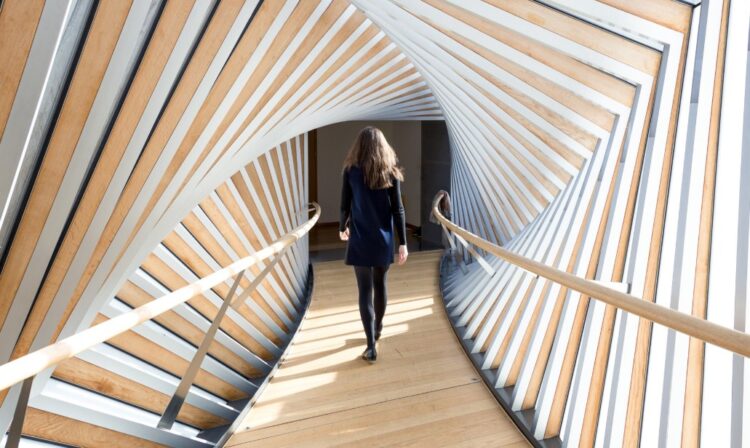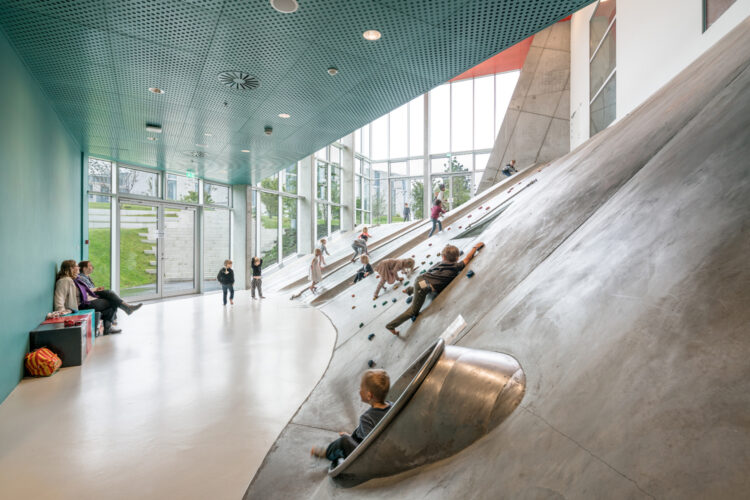The spaces we inhabit have a profound effect on our mental health and overall well-being. Thoughtful architectural design can promote relaxation, focus, creativity, and connection—while poorly designed buildings can negatively impact mood, increase stress and anxiety, and even contribute to depression.
As architects and designers, we have an opportunity and responsibility to create built environments that support mental health.
How Architecture Impacts Mental Health?

Access to Natural Light
One of the most direct ways that architecture impacts wellness is through access to natural light. Abundant daylight helps maintain circadian rhythms and vitamin D production, can improve sleep quality, and has even been linked to boosted serotonin levels.
Design strategies like maximizing window area, careful glazing selection, light shelves to reflect daylight deeper into interior spaces, skylights, and the strategic placement of windows in relation to task areas and seating can ensure occupants have ample exposure to natural light.
Views of nature also provide mental health benefits, so designing rooms with views of greenery and other natural elements is ideal.
Layout and Organization
Spatial layout and organization also influence mental health. Open, flexible layouts with defined zones for different functions promote free circulation and avoid feelings of confinement. However, completely open-plan offices can create distracting environments that generate stress, so striking the right balance is key.
Providing privacy when desired, through the strategic placement of partitions or designated quiet rooms, gives occupants greater control over their environment.
Organization strategies like thoughtfully planned circulation paths, clear wayfinding, and purposeful placement of common areas and activity hubs can also help avoid disorientation and cognitive fatigue. CK Architecture is one of best interior fit out companies in Dubai.
Architectural Rhythm

Architectural rhythm, achieved through consistent detailing, harmonious geometry, and cohesive material and color palettes, promotes calmness and order. Complex, cluttered, or chaotic spaces visually overstimulate occupants, while too-sterile environments feel cold and uninviting.
Finding a middle ground—for example, by repeating clean lines, angles, and proportions while incorporating textural variations—helps strike an optimal balance. Sensory design considerations like materiality, acoustics, olfactory elements, and incorporation of nature also influence how occupants emotionally experience a space.
Ergonomics & Accessibility
Ergonomics and accessibility are also important mental health considerations. Buildings and interiors that accommodate diverse physical needs and abilities help occupants feel included and avoid marginalization or discomfort.
Universal design elements like curb cuts, wide entryways, sensory wayfinding tools like color contrasts and tactile surfaces, and furnishings and fixtures designed for users of all mobilities promote dignity and independence. Careful acoustic planning to reduce disruptive noise and ensure comfortable sound levels helps decrease auditory stimulation.
Encourage Social Connection

On a larger scale, public spaces and neighborhoods designed to encourage social connection and a sense of community integration provide outlets for occupants to encounter diversity and combat isolation. Activating street fronts with seating, art displays, and green spaces gives residents visual interest.
Programmed community events and flexible outdoor areas for gathering to foster interaction and bonding among neighbors. High-quality outdoor lighting enhances actual and perceived safety. All of these measures can help cultivate social wellness.
Of course, those experiencing clinically diagnosed conditions or severe distress need specialized care and treatment. Thoughtful design alone cannot “cure” mental illness. However, the spaces we inhabit daily have a cumulative impact on overall wellness and quality of life.
By intentionally designing buildings and communities with mental health in mind, architects and urban planners can meaningfully contribute to societal wellbeing. This ethos of designing for total health—mind, body, and spirit—should be embedded in every project.
Conclusion
Architecture and design have profound implications for mental health, from access to natural light and views of nature to spatial layouts that provide privacy and reduce noise. Strategies like maximizing daylight exposure, providing circulation flexibility, and fostering community in neighborhood design can boost relaxation, focus, and social connection.
While design alone cannot cure mental illness, optimizing buildings for wellness through ergonomic, biophilic, and sensory design contributes meaningfully to public health and should inform every project. By being mindful of mental health needs in the design process, architects and planners can create built environments that holistically nurture body, mind and spirit.
 Hi Boox Popular Magazine 2024
Hi Boox Popular Magazine 2024



